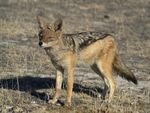Biology:Jackal
| Jackal | |
|---|---|
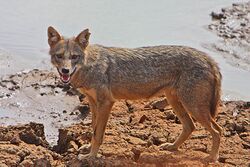
| |
| Golden jackal (Canis aureus) | |
| Scientific classification | |
| Kingdom: | Animalia |
| Phylum: | Chordata |
| Class: | Mammalia |
| Order: | Carnivora |
| Family: | Canidae |
| Subtribe: | Canina |
| Genus: | Canis |
| Groups included | |
| |
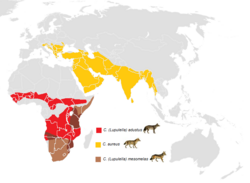
| |
| Cladistically included but traditionally excluded taxa | |
| |
Jackals are medium-sized omnivorous mammals of the genus Canis, which also includes wolves and the domestic dog. While the word "jackal" has historically been used for many small canids, in modern use it most commonly refers to three species: the closely related black-backed jackal and side-striped jackal of sub-Saharan Africa, and the golden jackal of south-central Eurasia, which is more closely related to other members of the genus Canis.
Jackals and coyotes (sometimes called the American jackal[1]) are opportunistic omnivores, predators of small to medium-sized animals and proficient scavengers. Their long legs and curved canine teeth are adapted for hunting small mammals, birds, and reptiles, and their large feet and fused leg bones give them a physique well-suited for long-distance running, capable of maintaining speeds of 16 km/h (9.9 mph) for extended periods of time. Jackals are crepuscular, most active at dawn and dusk.
Their most common social unit is a monogamous pair, which defends its territory from other pairs by vigorously chasing intruding rivals and marking landmarks around the territory with their urine and feces. The territory may be large enough to hold some young adults, which stay with their parents until they establish their own territories. Jackals may occasionally assemble in small packs, for example, to scavenge a carcass, but they normally hunt either alone or in pairs.[citation needed]
Etymology
The English word "jackal" dates back to 1600 and derives from the French chacal, derived from the Persian شغال shoghāl, which is in turn derived from the Sanskrit शृगाल ṥṛgālaḥ meaning "the howler".[2][3]
Taxonomy and relationships
| The extant wolf-like canids | ||||||||||||||||||||||||||||||||||||||||||||||||||||||||||||
| ||||||||||||||||||||||||||||||||||||||||||||||||||||||||||||
| Phylogenetic relationships between the extant wolf-like clade of canids based on mitochondrial DNA.[4][5] |
Similarities between jackals and coyotes led Lorenz Oken, in the third volume of his Lehrbuch der Naturgeschichte (1815), to place these species into a new separate genus, Thos, named after the classical Greek word θώς "jackal", but his theory had little immediate impact on taxonomy at the time. Angel Cabrera, in his 1932 monograph on the mammals of Morocco, questioned whether or not the presence of a cingulum on the upper molars of the jackals and its corresponding absence in the rest of Canis could justify a subdivision of that genus. In practice, Cabrera chose the undivided-genus alternative and referred to the jackals as Canis instead of Thos.[6]
Oken's Thos theory was revived in 1914 by Edmund Heller, who embraced the separate genus theory. Heller's names and the designations he gave to various jackal species and subspecies live on in current taxonomy, although the genus has been changed from Thos to Canis.[6]

The wolf-like canids are a group of large carnivores that are genetically closely related because they all have 78 chromosomes. The group includes genus Canis, Cuon, and Lycaon. The members are the dog (C. lupus familiaris), gray wolf (C. lupus), coyote (C. latrans), golden jackal (C. aureus), Ethiopian wolf (C. simensis), black-backed jackal (C. mesomelas), side-striped jackal (C. adustus), dhole (Cuon alpinus), and African wild dog (Lycaon pictus).[7] The latest recognized member is the African golden wolf (C. anthus), which was once thought to be an African branch of the golden jackal.[5] As they possess 78 chromosomes, all members of the genus Canis (coyotes, wolves, jackals) are karyologically indistinguishable from each other, and from the dhole and the African hunting dog.[8][9] The two African jackals are shown to be the most basal members of this clade, indicating the clade's origin from Africa.[4] Canis arnensis arrived in Mediterranean Europe 1.9 million years ago and is probably the ancestor of modern jackals.[10]
The paraphyletic nature of Canis with respect to Lycaon and Cuon has led to suggestions that the two African jackals should be assigned to different genera, Schaeffia for the side-striped jackal and Lupulella for the black-backed jackal[11][12] or Lupulella for both.[12][13]
The intermediate size and shape of the Ethiopian wolf has at times led it to be regarded as a jackal, thus it has also been called the "red jackal" or the "Simien jackal".
Species
| Species | Binomial authority | Description | Range |
|---|---|---|---|
| Black-backed jackal Canis mesomelas |
Schreber, 1775 | The most lightly built jackal, it is considered to be the oldest living member of the genus Canis.[14] It is the most aggressive of the Old World jackals, being known to attack animal prey many times its own weight, and it has more quarrelsome intrapack relationships.[15] | Southern Africa and eastern coast of Kenya, Somalia, and Ethiopia |
| Side-striped jackal Canis adustus 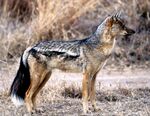
|
Sundevall, 1847 | It primarily resides in wooded areas, unlike other jackal species. It is the least aggressive of the jackals, rarely preying on large mammals.[16] | Central and southern Africa |
| Golden jackal Canis aureus 
|
Linnaeus, 1758 | The most widespread of the jackals, it is more closely related to wolves than to African jackal species. | Southeastern Europe, Middle East, western Asia, and South Asia |
| Gray jackal Canis anthus 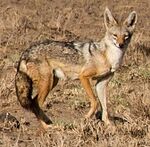
|
F. Cuvier, 1820 | Previously classified a variant of golden jackal. It was reclassified as its own species in 2015 when a series of analyses on the species' mitochondrial DNA and nuclear genome showed that it was genetically distinct from the golden jackal and other members of Canis.[5][17] | North and Northeastern Africa |
| Coyote Canis latrans 
|
Say, 1823 | The largest and heaviest of the jackals, it is also known as the "American jackal"[18] It, like the black-backed jackal, it is capable of bringing down prey many times its size. The only known fatal attacks on humans occurred in 1981 on a three-year-old American girl[19] and in 2009 when a pack of coyote-wolf hybrids [20] attacked a nineteen-year-old Canadian woman at Cape Breton Highlands National Park.[21] | North America |
Interbreeding with dogs
Experiments in Germany with breeding poodles and golden jackals have produced hybrids. The results showed that, unlike wolf–dog hybrids, jackal–dog hybrids show a decrease in fertility, significant communication problems, and an increase of genetic disorders after three generations of interbreeding.[22]
In Russia, golden jackals are one of the founder breeds of the Sulimov dog, a working dog owned exclusively by Aeroflot and used for bomb detection in airport security.
Folklore, mythology, and literature
- Like foxes and coyotes, jackals are often depicted as clever sorcerers in the myths and legends of their regions.
- Anubis (Ancient Greek: Ἄνουβις) is the Greek name for a jackal-headed god associated with mummification and the afterlife in ancient Egyptian religion.
- The jackal (likely the golden jackal, given its present range) is mentioned roughly 14 times in the Bible. It is frequently used as a literary device to illustrate desolation, loneliness, and abandonment, with reference to its habit of living in the ruins of former cities and other areas abandoned by humans. It is called "wild dog" in several translations of the Bible.
- Serer religion and creation myth posits the jackal was among the first animals created by Roog, the supreme deity of the Serer people.[23]
- Pablo Neruda's poem "I Explain a Few Things" describes Francisco Franco and his allies as "...Jackals that the jackal would drive off...".
- In Rudyard Kipling's collection of stories The Jungle Book, the mad cowardly golden jackal Tabaqui is a companion of Shere Khan.
- In the King James translation of the Bible, Isaiah 13:21 refers to 'doleful creatures', which some commentators suggest are either jackals or hyenas.[24]
- Literature in India and Pakistan compares jackal with lion in terms of courage. A famous saying is "One day life of a lion is better than a hundred years life of a jackal (Tipu Sultan)".
- Several jackals are featured prominently throughout the Swiss Family Robinson.
- The 'Jackal' is the famed nickname of Adrius au Augustus, one of the main antagonists in Pierce Brown's Red Rising Trilogy.
- In Bengali tantrik traditions jackals are considered as representative of Goddess Kali. It is said that the Goddess appears as jackals when meat is offered to her.
References
- ↑ Coyote (2004) by E.M. Gese & M. Bekoff
- ↑ "jackal". The American Heritage Dictionary of the English Language. http://www.ahdictionary.com/word/search.html?q=jackal.
- ↑ Harper, Douglas. "jackal". Online Etymology Dictionary. https://www.etymonline.com/?term=jackal.
- ↑ 4.0 4.1 Lindblad-Toh, K.; Wade, C. M.; Mikkelsen, T. S.; Karlsson, E. K.; Jaffe, D. B.; Kamal, M. Jdjndnd; Clamp, M.; Chang, J. L. et al. (2005). "Genome sequence, comparative analysis and haplotype structure of the domestic dog". Nature 438 (7069): 803–819. doi:10.1038/nature04338. PMID 16341006. Bibcode: 2005Natur.438..803L.
- ↑ 5.0 5.1 5.2 Koepfli, K.-P.; Pollinger, J.; Godinho, R.; Robinson, J.; Lea, A.; Hendricks, S.; Schweizer, R. M.; Thalmann, O. et al. (2015-08-17). "Genome-wide Evidence Reveals that African and Eurasian Golden Jackals Are Distinct Species". Current Biology 25 (16): 2158–65. doi:10.1016/j.cub.2015.06.060. PMID 26234211. http://www.cell.com/current-biology/abstract/S0960-9822%2815%2900787-3.
- ↑ 6.0 6.1 Thos vs Canis
- ↑ Wayne, R. (1993). "Molecular evolution of the dog family". Trends in Genetics 9 (6): 218–24. doi:10.1016/0168-9525(93)90122-X. PMID 8337763.
- ↑ Robert K. Wayne; Jennifer A. Leonard; Carles Vila (2006). "Chapter 19:Genetic Analysis of Dog Domestication". in Melinda A. Zeder. Documenting Domestication:New Genetic and Archaeological Paradigms. University of California Press. pp. 279–295. ISBN 978-0-520-24638-6. https://books.google.com/books?id=EaVTxjrbIFQC&pg=PA279.
- ↑ Wurster-Hill, D. H.; Centerwall, W. R. (1982). "The interrelationships of chromosome banding patterns in canids, mustelids, hyena, and felids". Cytogenetics and Cell Genetics 34 (1–2): 178–192. doi:10.1159/000131806. PMID 7151489.
- ↑ Miklósi, Adam (2008). "4.2.1". Dog behaviour : evolution and cognition. Oxford: Oxford University Press. ISBN 9780199545667. https://books.google.com/books?id=h9rsmyaywPUC&pg=PT164. Retrieved 27 May 2017.
- ↑ Zrzavy, J.; Ricankova, V. (2004). "Phylogeny of recent Canidae (Mammalia, Carnivora): relative reliability and the utility of morphological and molecular datasets". Zool. Scr. 33 (4): 311–333. doi:10.1111/j.0300-3256.2004.00152.x.
- ↑ 12.0 12.1 Privosti, Francisco J. (2010). "Phylogeny of the large extinct South American Canids (Mammalia, Carnivora, Canidae) using a total evidence approach". Cladistics 26 (5): 456–481. doi:10.1111/j.1096-0031.2009.00298.x.
- ↑ Dinets V. The Canis tangle: a systematics overview and taxonomic recommendations. Vavilovskii Zhurnal Genetiki i Selektsii – Vavilov Journal of Genetics and Breeding. 2015;19(3):286-291.
- ↑ Macdonald, David (1992). The Velvet Claw. p. 256. ISBN 978-0-563-20844-0. https://archive.org/details/velvetclawnatura00macd/page/256.
- ↑ Estes, Richard (1992). The behavior guide to African mammals: including hoofed mammals, carnivores, primates. University of California Press. ISBN 978-0-520-08085-0. https://archive.org/details/isbn_0520080858.
- ↑ "Side-Striped Jackal". Canids.org. Archived from the original on 2009-02-20. https://web.archive.org/web/20090220010219/http://www.canids.org/species/Side-striped_jackal.pdf. Retrieved 2010-03-19.
- ↑ (in Spanish) Urios, Vicente; Donat-Torres, Maria P.; Ramírez, Carlos; Monroy-Vilchis, Octavio; Hamid Rgribi-Idrissi (2015): El análisis del genoma mitocondrial del cánido estudiado en Marruecos manifiesta que no es ni lobo (Canis lupus) ni chacal euroasiático (Canis aureus). figshare. doi:10.6084/m9.figshare.1524971
- ↑ Coyote (2004) by E.M. Gese & M. Bekoff
- ↑ https://www.desertsun.com/story/life/home-garden/james-cornett/2014/08/23/james-cornett-coyotes-humans/14516033/
- ↑ Kays, Roland; Curtis, Abigail; Kirchman, Jeremy J.. "Rapid adaptive evolution of northeastern coyotes via hybridization with wolves". Rsbl.royalsocietypublishing.org. http://rsbl.royalsocietypublishing.org/content/6/1/89.short. Retrieved 2014-07-04.
- ↑ https://www.cnn.com/2009/SHOWBIZ/Music/10/29/canada.singer.killed/index.html
- ↑ Feddersen-Petersen, Dorit (2004) (in de). Hundepsychologie (4th ed.). Stuttgart: Franck-Kosmos-Verlag. ISBN 978-3-440-09780-9.
- ↑ Thiaw, Issa laye (23–24 June 2009), "Mythe de la création du monde selon les sages sereer" (in French), Enracinement et Ouverture — "Plaidoyer pour le dialogue interreligieux" (Dakar: Konrad Adenauer Stiftung): pp. 45–50, http://www.kas.de/wf/doc/kas_17308-1522-1-30.pdf?090827174112
- ↑ "Jackal", classic.net.bible.org; accessed 26 February 2015.
Further reading
- The New Encyclopedia of Mammals edited by David Macdonald, Oxford University Press, 2001; ISBN 0-19-850823-9
- Cry of the Kalahari, by Mark and Delia Owens, Mariner Books, 1992.
- The Velvet Claw: A Natural History of the Carnivores, by David MacDonald, BBC Books, 1992.
- Foxes, Wolves, and Wild Dogs of the World, by David Alderton, Facts on File, 2004.
External links
- Jackal at the African Wildlife Foundation
- Jackals at A-Z Animals
- Jackals of the African Crater at PBS.org
- Jackal is a meaningless term
